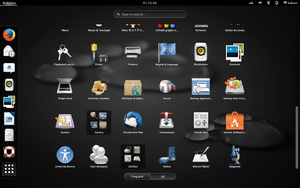Ubuntu GNOME
Ubuntu GNOME (formerly Ubuntu GNOME Remix) is a Linux distribution and distributed as free and open source software. From version 13.04 onwards, it is an official "flavour" of the Ubuntu operating system[1] which uses a pure GNOME desktop environment rather than the Unity graphical shell.[2]
The project began as an unofficial "remix" because some users preferred the GNOME 3 desktop over Unity.[3] Ubuntu GNOME 12.10 Quantal Quetzal was the first stable version released on 18 October 2012.[4]
Releases
| Current release |
Release no longer supported |
Release still supported |
Future release |
| Version |
Code Name |
Release date |
Supported Until |
Remarks |
| 12.10 |
Quantal Quetzal |
2012-10-18 |
April 2014 |
|
| 13.04 |
Raring Ringtail |
2013-04-26 |
December 2013 |
- Firefox replaced GNOME Web (Epiphany) as the default browser.
- Ubuntu Software Center and Update Manager replaced GNOME Software (gnome-packagekit).
- LibreOffice 4.0 became available by default instead of Abiword and Gnumeric.
|
| 13.10 |
Saucy Salamander |
2013-10-17 |
May 2014 |
|
| 14.04 LTS |
Trusty Tahr |
2014-04-17 |
April 2017 |
- release with long-term support (LTS) for three years[5]
- includes a "GNOME Classic" session available by default in the session menu[6]
|
| 14.10 |
Utopic Unicorn |
2014-10-23 |
July 2015 |
- Most of GNOME 3.12 was included
- gnome-maps and gnome-weather were installed by default
- GNOME Classic session was included and selectable at log-in[7]
|
| 15.04 |
Vivid Vervet |
2015-04-23[8] |
December 2015 |
|
Reception
Writing in October 2013, Jim Lynch stated:
| “ |
Ubuntu GNOME 13.10 will be welcomed by GNOME fans. GNOME 3.8 adds some significant new features that enhance the desktop experience, and all of it has been combined well with Ubuntu 13.10 itself. So the end result will probably be quite appealing for those who want Ubuntu, but with GNOME 3.8 instead of Unity. If you are not a fan of GNOME 3 then Lubuntu, Kubuntu or Xubuntu are much better desktop environments if you need to stay within the Ubuntu family. If none of those appeal to you then you might want to just sit tight and wait for Linux Mint 16 to arrive.[10] |
” |
Jim Lynch reviewed Ubuntu GNOME 14.04 LTS again in April 2014 and concluded,
| “ |
I have seen some reviews of regular Ubuntu 14.04 that have proclaimed it to be “the best version of Ubuntu yet” and that sort of thing. Well, I think it’s fair to say that Ubuntu GNOME 14.04 may also be the finest version of Ubuntu GNOME as well, and that’s something that the Ubuntu GNOME developers and users can take pride in.[11] |
” |
See also
References
External links
|
|---|
| | General | |
|---|
| | People | |
|---|
| | Derivatives | |
|---|
| | Applications | | Discontinued | |
|---|
| | Related applications | |
|---|
|
|---|
| Technology and
User interface |
|
|---|
| | Hardware | |
|---|
| | Support |
|
|---|
| | Fonts | |
|---|
| | Media | |
|---|
| Related
topics | |
|---|
| |
|
